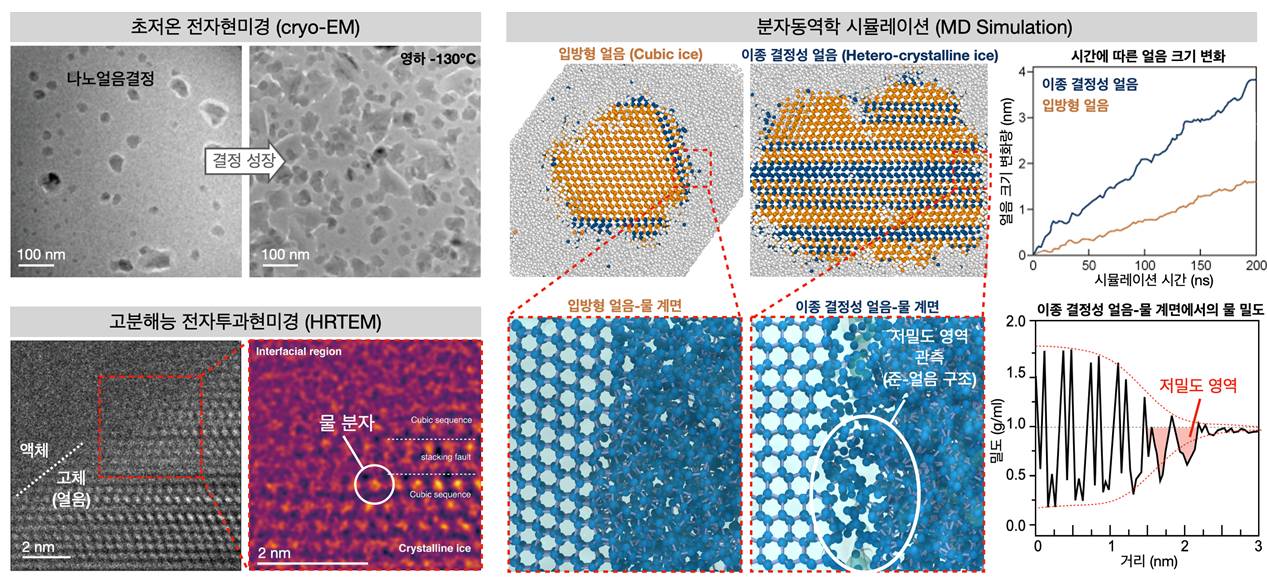Professor Kang Min-ho and His Research Team Paves the Path of Ice Nano-technology
- Writer :관리자
- Date :2024.02.08
- Views :511
- The first to discover the initial crystallization formation of nanocrystalline ice and its transformation process
- Professors Kang Min-ho (Catholic University of Korea), Ahn Dong-jun (Korea University), and Park Jung-won (Seoul National University) published in Nature Communications
The research teams, each led by CUK Professor Kang Min-ho of Biomedical-Chemical Engineering, KU Professor Ahn Dong-jun of Chemical and Biological Engineering, and SNU Professor Park Jung-won of Chemical and Biological Engineering, published a revolutionary study on the growth mechanism of nanocrystalline ice.
In this research, cryo-electron microscopy (cryo-EM) experiments and molecular dynamics (MD) simulations were used to successfully track the early stages of ice crystals in nanoscale. Through this, they discovered the unique growth mechanisms and interface structures behind the early stages of ice crystallization, and the said research findings were published online in Nature Communications (IF=16.6), one of the leading journals in the field of natural science, on January 30.
- Author information: Ahn Dong-jun (Co-corresponding author, KU), Park Jung-won (Co-corresponding author, SNU), Lee Min-young (Co-1st author, SNU), Lee Sang-yup (Co-1st author, KU), Kang Min-ho (Co-1st author, CUK), Won Tae-kyung (Co-author, KU), Kang Sung-su (Co-author, SNU), and Kim Jae-deok (Co-author, SNU)
- Title: Observing growth and interfacial dynamics of nanocrystalline ice in thin amorphous ice films
- Info: Nature Communications, DOI: 10.1038/s41467-024-45234-x (Published on January 30, 2024)
According to the study, the ice that forms in the early stage appears in three types: cubic ice, hexagonal ice, and hetero-crystalline ice, which is a mixture of the first two. Among them, the cubic ice has a relatively small crystal size and is limited in growth, but the hetero-crystalline ice shows rapid growth, particularly along the prism area, which sees faster growth than the basal area.
It is found that such growth happens due to the difference in density and structure in the water molecules that appear in the water and ice interface. Whereas the water molecules near the slowly growing cubic ice barely show any difference from the ones in liquid water in terms of density and structure, the hetero-crystalline ice’s water molecules on the ice surface hold relatively low density and high tetrahedral patterns like a pseudo-ice. The cluster structure in the water molecule on the ice interface was discovered to be adjusted by the difference of surface energy in each ice layer.

▲ Illustration. Cryo-EM, high-resolution transmission electron microscope, and MD simulations were utilized to observe the ice growth in nanoscale. The cubic ice and hetero-crystalline ice were found to be different in their growth mechanism and interface structure. The latter showed rapid growth, and its particular interfaces had the structure of pseudo-ice structures with low density.
This study provided a new scientific understanding of the growth mechanism and formation of ice in the early stages and paved the path for the development of new technologies that control ice growth in nano-size. This could also lead to breakthrough findings in various fields and areas, such as climate change, aircraft safety, subzero batteries, ice control in various industrial machines, and cold-chain industries where food and medicine are stored at a low temperature. The research team expected that their study would provide the ice-related industries and the environmental field with a new series of insights and solutions.
* Cryo-EM: The sample is retained in its original structure through quick freezing, and the high-resolution image is used to uncover its atomic structures.
* DM simulation: Calculates the dynamics of the atoms by resolving Newton’s motion equation numerically when the atoms are forced among each other.

Ahn Dong-jun (Correspondent, KU), Park Jung-won (Correspondent, SNU), Lee Min-young (1st author, SNU), Lee Sang-yup (1st author, KU), and Kang Min-ho (1st author, CUK)

